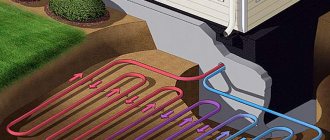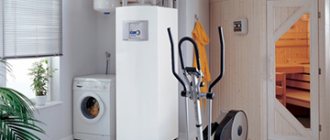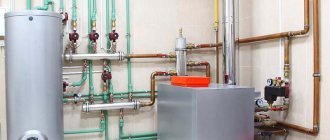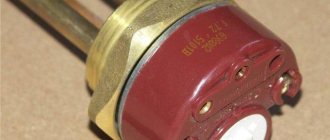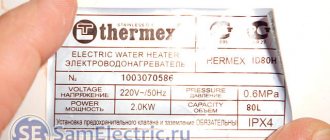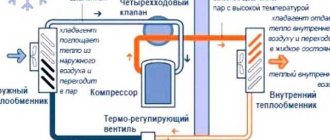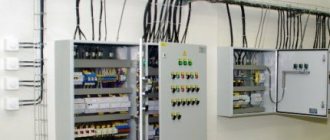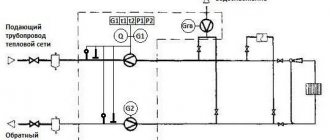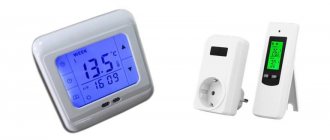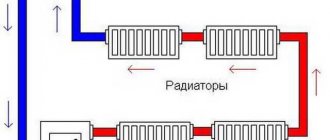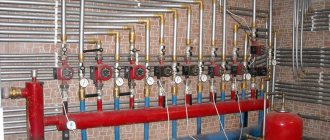Boiler houses burn gas, coal or fuel oil. As a result, heat is generated, which is supplied through pipes to apartment buildings using a coolant. In the private sector, gas, coal or wood can also be burned to obtain heat. In some rare cases, electricity may be used for heating.
Currently, there are effective developments of heat pumps (hereinafter referred to as HP). They can be used for heating private houses, garden houses and garages.
Features of heat pumps
To obtain thermal energy, HP does not use energy carriers, and therefore does not harm the environment. Such an installation produces more thermal energy than it consumes electricity.
Principle of operation
The operation of HP is based on the principle of heat transfer from a colder source to a warmer one. That is, it makes colder things even colder, and warmer things even warmer. This means that the idea of a perpetual motion machine is not incorporated here, because in total the amount of heat remains unchanged, and electricity is spent only on the separation and transfer of heat.
What are they for?
A heat pump can be used for both heating and cooling because it separates and transfers heat. This means that the part of the installation that becomes colder can be used to lower the temperature, and the other part - to raise it.
What is a heat pump and how does it work
The term heat pump refers to a set of specific equipment. The main function of this equipment is to collect thermal energy and transport it to the consumer. The source of such energy can be any body or environment with a temperature of +1º or more degrees.
There are more than enough sources of low-temperature heat in our environment. This is industrial waste from enterprises, thermal and nuclear power plants, sewage, etc. To operate heat pumps in home heating, three self-regenerating natural sources are needed - air, water, and earth.
The three listed potential energy suppliers are directly related to the energy of the sun, which, by heating, moves the air with the wind and transfers thermal energy to the earth. It is the choice of source that is the main criterion according to which heat pump systems are classified.
The operating principle of heat pumps is based on the ability of bodies or media to transfer thermal energy to another body or environment. Receivers and suppliers of energy in heat pump systems usually work in pairs.
The following types of heat pumps are distinguished:
- Air is water.
- Earth is water.
- Water is air.
- Water is water.
- Earth is air.
- Water - water
- Air is air.
In this case, the first word determines the type of medium from which the system takes low-temperature heat. The second indicates the type of carrier to which this thermal energy is transferred. Thus, in heat pumps, water is water, heat is taken from the aquatic environment and liquid is used as a coolant.
Modern heat pumps use three main sources of thermal energy. These are soil, water and air. The simplest of these options is an air source heat pump. The popularity of such systems is due to their fairly simple design and ease of installation.
However, despite such popularity, these varieties have rather low productivity. In addition, the efficiency is unstable and dependent on seasonal temperature fluctuations.
As the temperature drops, their performance drops significantly. Such heat pump options can be considered as an addition to the existing main source of thermal energy.
Equipment options that use ground heat are considered more effective. The soil receives and accumulates thermal energy not only from the Sun, it is constantly heated by the energy of the earth's core.
That is, the soil is a kind of heat accumulator, the power of which is practically unlimited. Moreover, the soil temperature, especially at some depth, is constant and fluctuates within insignificant limits.
Scope of application of energy generated by heat pumps:
The constancy of the source temperature is an important factor in the stable and efficient operation of this type of power equipment. Systems in which the aquatic environment is the main source of thermal energy have similar characteristics. The collector of such pumps is located either in a well, where it ends up in an aquifer, or in a reservoir.
The average annual temperature of sources such as soil and water varies from +7º to + 12º C. This temperature is quite enough to ensure efficient operation of the system.
Types of pumps
There are different types of heat pumps, but they are all based on the principle of producing heat or cold by separating thermal energy and transferring it. Only one TN Frenette is different. The cavitation method of obtaining thermal energy using a hydrodynamic generator is a type of heat pump.
The thermal energy that is used to heat the building is a consequence of energy conversion carried out using a heat pump. Moreover, they obtain heat without burning fuel, but by cooling the external environment and releasing thermal energy indoors, that is, in this case, the law of conservation of energy is observed: how much thermal energy is taken from the external environment, the same amount is released inside the building. Most of these household devices use heat from the sun, which is accumulated by the surface of the earth, water or air.
Therefore, according to the type of primary circuit, all structures can be divided into air, ground and water.
Based on the type of coolant (W - water, G - soil) in the circuits, pumps can be divided into eight types:
- B—B;
- G-V;
- G—air;
- air—B;
- air—air;
- To the air;
- refrigerant—B;
- refrigerant - air.
They can also use the heat of the exhaust air, heating the supply air, that is, operate in recovery mode.
Air-to-air
The principle of operation of a heat pump is similar to that used in an air conditioner in heating mode, but has the only difference. The heater is set to heating, and the air conditioner is set to reduce the temperature in the room.
The principle of operation of the B-B installation is as follows: the air, even at low temperatures, has a certain amount of energy. Only at absolute zero is there no thermal energy. Most HPs are capable of receiving heat at a temperature of –15 °C. Currently, some manufacturers produce stations that retain heat extraction at –30 °C. Heat is collected through the evaporation of freon, which circulates through the internal circuit. For this purpose, an evaporator is used in which the refrigerant is converted from liquid to gaseous state. This absorbs heat.
The next block, which is located in the B-V heating system, is the compressor, which converts freon from a gaseous state into a liquid. This generates heat. The efficiency of the V-V installation directly depends on the ambient temperature. The lower it is, the lower the station’s productivity.
Air-water
Air-to-water HP is the most universal model. It is very effective in the warm season, but in the cold season the performance drops significantly. Simple installation is an advantage of the system. Suitable equipment can be installed anywhere. The heat that is removed from the room in the form of gas or smoke can be reused.
A water heat pump takes heat from groundwater, which is pumped through the evaporator. Such a pump is distinguished by good efficiency and increased stability: efficiency is the result of significant heat transfer from water.
Of course, to use an installation of this type, there must be sufficient groundwater in the area. It is advisable that the water is no deeper than 30 meters.
Water-water
With such a system, an easily evaporating liquid, such as freon, circulates in the internal circuit. The indoor circuit can be water pipes, registers or radiators filled with water.
Any body of water with a sufficiently large amount of water can act as an external contour. This could be a river, lake or pond. In this case, the coolant takes heat from the external circuit and transfers it to the internal circuit.
Geothermal
The HP uses the stored thermal energy of the earth as a heat source. Such pumps are considered the most efficient because the ground temperature remains constant throughout the year.
These systems are divided into horizontal and vertical. But this method requires a fairly large area for horizontal pipes, and for vertical systems it is necessary to perform significant excavation work.
Prices for different types of heat pumps
Heat pump
DIY heat pump for heating
Such a device will be a godsend for owners of dachas and private houses that are not connected to gas.
The main advantage of this method of heating a room over others is that heat pumps consume little energy and are able to heat a room quite efficiently. With a heat pump like the one made by the author, a house of 2.5 floors and an area of 213 sq. m. is partially heated. meters. The installation uses two 24,000 BTU compressors, resulting in electricity consumption of about 4 kilowatts per hour, and 16-18 kilowatts of heat generated.
Two compressors are needed in order to increase their service life, as well as to reduce the inrush currents that occur when turned on.
Materials and tools for manufacturing: - two compressors; - thermostatic valve; — a metal tank to create a capacitor; - copper pipe to create a coil; — a plastic barrel for creating an evaporator (about 120 l); — brackets and other fasteners; — TRV; - single-phase starting relay and other elements.
Heat pump manufacturing process:
Step one. Compressor installation
The compressor capacity should be around 25,500 Btu. it is attached to the wall as shown in the picture. L-300mm brackets are used for this.
Step two.
Condenser design To create a condenser you will need a stainless steel tank with a capacity of 120 liters. The tank was cut into two pieces and then the freon coil was inserted into it. After that, the tank was welded back. Also at this stage you will need to weld several technical threaded connections. The area of the copper pipe of the coil is calculated by the formula M2 = kW/0.8 x ∆t. ∆t – difference in water temperature at the inlet and outlet of the system. For the author, this is 35s-30s = +5 degrees C. M2 is the area of the coil pipe (square meters). kW – heat generation power by the system (with the compressor running) in kW. 0.8 – coefficient of thermal conductivity of copper/water under the condition of counterflow of media.
As a result, the heat exchange area of the coil is about two square meters.
The coil is made of a copper tube, which is wound around any object of suitable shape, for the author it is a gas cylinder. The total length of the pipe was 35 meters. In order for the structure to be durable, it must be fixed using two aluminum slats and copper wire. The ends of the coil are removed using plumbing leads. Instead of a crimp ring, linen rope with sealant was used.
Step three. Evaporator device
To create an evaporator you will need a 127 liter plastic barrel with a wide neck. The evaporator is made according to the same principle as the condenser. That is, you will need a copper pipe 25 meters long, from which you need to make a coil.
This type of evaporator is flooded. Liquid freon enters through the coil from below, then evaporates in it and then spreads in the form of gas, then moves to the compressor. This improves heat transfer.
Transitions are suitable for plastic PE 20*3/4', from drinking water. Water supply and drainage occurs through ordinary sewer pipes. Subsequently, the evaporator is mounted on brackets measuring L-400mm.
Step four.
Connecting the expansion valve The expansion valve is used by Honeywell. When soldering, you need to be extremely careful, since the expansion valve cannot withstand temperatures exceeding 100 degrees. Before soldering, you need to wrap the expansion valve with a wet cloth, so cooling will occur.
Step five.
Assembling the device. For assembly you will need a Rotenberg hard soldering kit. You will also need three electrodes with zero silver content and one electrode with 40% silver content for soldering on the compressor side. As a result, the connection will be vibration-resistant. You must remember to solder the Schrader filling valve into the system; it must have a nipple for connecting the hose. It is soldered at the inlet to the compressor. The inlet pipe of the expansion valve equalizer is soldered after the evaporator, but before the cylinder. Before soldering, the spool must be turned out, as the rubber seal will melt.
Step six.
Refilling with freon Before refueling, you need to remove air from the system; to do this, a certain amount of freon is supplied to it to displace it. To refill you will need no more than 2 kg of freon. To refuel, you will need a pressure gauge; you can use it to monitor the process.
Step seven.
Electronics To start the system, a starting relay is required, so the starting currents are about 40 A. There must be a fuse, as well as a panel with a DIN rail. You will also need a thermal sensor, with the help of which the system will automatically turn off when a certain temperature is reached.
According to the author, immediately after the first launch the system worked as it should. Now you can connect the heating circuit and conduct heat throughout the house where it is needed. After this, you will need to make adjustments to the pressure and expansion valve.
Source
Become the author of the site, publish your own articles, descriptions of homemade products and pay for the text. Read more here.
Assembling a simple pump from an air conditioner
Modern air conditioners can perform the function of an air-to-air heat exchanger. But their performance drops along with the outside temperature.
By modifying the air conditioner, you can get a really working pump model. To do this, you can assemble a homemade HP with your own hands according to working versions of the drawings from an air conditioner, which takes energy not from the outside air, but from running water. In this case, only the compressor is used from the air conditioner.
Stages of work:
- A heat exchanger needs to be made for the compressor. A copper tube 30 meters long is wound in the shape of a coil on a cylinder. After which this structure must be placed in a steel container that has connections for water.
- The compressor must be connected to the lower inlet of the heat exchanger, and a control valve must be connected to the upper inlet.
- It is best to have a technician charge the system with freon.
- Next, the entire structure should be checked and a test run of the HP should be performed.
- After eliminating the shortcomings, the system is disconnected from the voltage, everything is secured, covered with a protective casing and put into operation.
Varieties
When talking about the types of heating elements, they indicate the source medium and the recipient medium through which the house is heated. Thus, the following types of these devices are distinguished:
- HP type "soil - water" : in this version, the source medium is soil. The pipeline with brine or antifreeze circulating through it can be placed horizontally from 2 to 5 meters below ground level (a large area will be required) or vertically in a well 150 - 200 m deep. The consumer of the pumped out thermal energy is the working medium of the water system heating.
- HP of the “water-to-water” type : in this case, the external circuit pipes are not immersed in the ground, but in a nearby body of water (if, of course, one is available). It is important that the reservoir does not freeze to its entire depth even in the most severe frost. Of course, immersing the outer circuit in water is much easier than burying it in the ground, so if there is a reservoir, this option is the most preferable.
- HP type "air - water" : HP with the simplest device, but also the least productive. There is simply no external circuit; the evaporator is mounted on the wall outside the house and is blown by a fan. While the temperature in soil and water does not drop beyond +5 degrees, the air can cool down to -30, so heat pumps of the “air-water” or “air-air” type (heating the house is carried out according to the principle of a fan heater) do not always work effectively .
Assembling a pump from an old refrigerator
There are two ways to make a heat pump from an old refrigerator.
In the first case, the refrigerator must be located indoors, and 2 air ducts must be laid outside and cut into the front door. Air enters the freezer through the upper one, the air is cooled, and through the lower air duct it leaves the refrigerator. The room is heated by a heat exchanger located on the rear wall.
Using the second method, making a heat pump with your own hands is also quite simple. To do this, you will need an old refrigerator; it just needs to be built outside the heated room.
Such a heater can operate at outside temperatures down to minus 5 ºС.
Manufacturing of geothermal installation
It is quite possible to make a geothermal installation with your own hands. In this case, the thermal energy of the earth is used to heat the home. Of course, this is a labor-intensive process, but the benefits are significant.
Calculation of the pump circuit and heat exchangers
The circuit area for HP is calculated at the rate of 30 m² per kilowatt. A living space of 100 m² requires about 8 kilowatt/hour of energy. This means the contour area will be 240 m².
The heat exchanger can be made from a copper tube. Inlet temperature 60 degrees, outlet 30 degrees, thermal power 8 kilowatt/hour. The heat exchange area should be 1.1 m². Copper tube with a diameter of 10 millimeters, safety factor 1.2.
Circumference in meters: l = 10 × 3.14 / 1000 = 0.0314 m.
Quantity of copper tube in meters: L = 1.1 × 1.2 / 0.0314 = 42 m.
Necessary equipment and materials
In many ways, success in the manufacture of heat pumps depends on the level of preparedness and knowledge of the contractor himself, as well as on the availability and quality of everything necessary for installing a heat pump.
Before starting work, you need to purchase equipment and materials:
- compressor;
- capacitor;
- controller;
- polyethylene fittings intended for assembling manifolds;
- pipe to the earth circuit;
- circulation pumps;
- water hose or HDPE pipe;
- pressure gauges, thermometers;
- copper tube with a diameter of 10 millimeters;
- insulation for pipelines;
- set of seals for sealing.
How to assemble a heat exchange block
The heat exchange block consists of two components. The evaporator must be assembled according to the “pipe-in-pipe” principle. The inner copper tube is filled with freon or other rapidly boiling liquid. Water from the well circulates through the outside.
Before assembling the capacitor, it is necessary to wind the copper tube in the form of a spiral and place it in a metal barrel with a capacity of at least 0.2 m³. The copper tube is filled with freon, and the barrel of water is connected to the home heating system.
Construction of the soil contour
In order to prepare the required area for the soil contour, a large amount of excavation work is required, which should preferably be carried out mechanized.
You can use 2 methods:
1. In the first method, it is necessary to remove the top layer of soil to a depth below its freezing. At the bottom of the resulting pit, lay the free part of the outer pipe of the evaporator in a snake and reclaim the soil.
2. In the second method, you first need to dig a trench across the entire planned area. The pipe is laid in it.
Then you need to check the tightness of all connections and fill the pipe with water. If there are no leaks, you can fill the structure with earth.
Refueling and first start
After installation is completed, the system must be filled with refrigerant. It is best to entrust this work to a specialist, because special devices are used to fill the internal circuit with freon. When filling, you need to measure the pressure and temperature at the compressor inlet and outlet.
After refueling is completed, you need to turn on both circulation pumps at the lowest speed, then start the compressor and monitor the operation of the entire system using thermometers. When the line warms up, frosting is possible, but after the system is completely warmed up, the frosting should melt. Grundfos circulation pump you will find the answer in the link.
Schematic diagram
Schematic diagram of the operation of a heat pump.
In a closed circuit, alternate evaporation, compression, condensation (liquefaction) and expansion of the working substance - the refrigerant, boils at a low temperature - occurs.
1.Evaporator - The evaporator contains low pressure liquid refrigerant. Its temperature is lower than the temperature of the heat source. Therefore, heat from the heat source is transferred to the refrigerant, which causes the refrigerant to evaporate.
2. Compressor - gaseous refrigerant is compressed in a compressor to high pressure and at the same time heats up so much that the temperature of the refrigerant after compression becomes higher than the temperature required for heating and hot water. In addition, the compressor drive energy is also converted into heat and “flows” to the refrigerant.
3. Condenser - a very hot high-pressure refrigerant gives off all its heat in the condenser, that is, the heat received from the heat source, as well as the heat from the compressor drive energy into the heating system (thermal potential difference). In this case, the refrigerant cools greatly and becomes liquid again.
4.Expansion valve - The refrigerant then passes through the expansion valve and returns to the evaporator. The expansion valve decompresses to the original pressure. The cycle has ended.
Operating modes of heat pumps - HP (heat pump) for space heating - depending on typical conditions - can be operated in a wide variety of ways. The choice of one or another operating mode should be guided, first of all, by the heat transfer systems already existing in the building or planned and on the selected heat source:
1). Monovalent mode
We are talking about a monovalent operating mode when the heat pump (heat pump) covers the entire heat demand for heating and domestic hot water. The optimal heat sources for this are soil and groundwater, since these heat sources are almost independent of the outside temperature and supply quite enough heat even at low temperatures.
2). Bivalent mode
In bivalent mode, along with the heat pump, a second heat generator is always used, most often an existing liquid fuel boiler. In the past, this type of operation was of great importance for one- and two-family houses, especially in combination with an air-water heat pump (heat pump). In this case, the main heat supply was carried out by a heat pump, and, starting from the outside temperature, for example, below 0°C, an oil-fuel boiler was connected to operation. For economic reasons - since two heat generators are always required - such systems are not currently widespread and are implemented only in certain rare cases.
